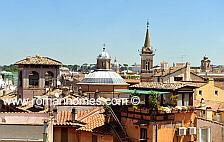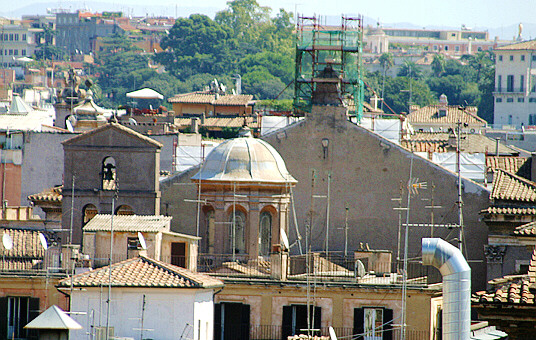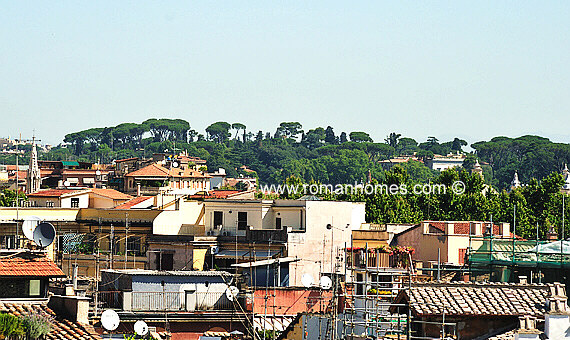|
Navona 4 bedroom 4 bathrooms attic with 2 terraces and 360 degree panoramic Rome views
All the DOMES and SIGHTS YOU CAN SEE
- BRING YOUR BINOCULARS!
|
Designer four bedroom (five bedrooms in the good season) four bathrooms apartment with sitting room, dining room, two expansive terraces / roof garden endowed with 360 degrees panoramic views of nearly all Rome's sights. Elevator. Now with a second kitchen near the terrace! BRING YOUR BINOCULARS!
Visit also:
|
PENTHOUSE PRESENTATION INDEX
|
Imagine yourself in the two terraces of the Rome Panorama apartment. Sit down, relax, and both with the naked eye, or with the help of a binocular, you can enjoy the view of the domes, sights and monuments, as you turn counter-clockwise.
The two chariots with winged Victory statues emerging over old Rome's roofs are part of the of Victor Emmanuel II memorial (in Italian Vittoriale).
The monument is also called Altar of the Fatherland (Altare della Patria), as it hosts the Unknown Soldier of WWI.
It is dedicated to the King of the Savoy dinasty who united Italy in 1861, nearly 1,400 years after the collapse of the ancient Roman Empire. Rome became capital of Italy though a few years later, in 1870.
The monument is dubbed wittingly by the Romans "the typewriter", while the American soldiers during WW2 called it "the wedding cake", for its huge lateral ramparts and its high colonnade. Designed by the architect Giuseppe Sacconi, it took 26 years to build (1885-1911). |
 |
The construction is still debated to this day, as it required the dismantlement of a part of Capitol Hill (the most important of Rome's 7 hills), destroying churches and ancient Roman ruins.
To the left of the Vittoriale you can see the dome of the Jesus Church (Chiesa del Gesu'), the main church of the Jesuite order, and immediately beneath it (in the photo) the roofs of Palazzo Altieri (17th century).
In the right photo, taken from another spot of the two terraces, and with wider angle, you can see one of the brownish towers of Palazzo Venezia. Formerly the embassy of the Republic of Venice, afterwards of the Austrian Empire, during the last century it was the seat of the Fascist government. Currently it hosts the Ministry of Cultural Resources (Ministero dei Beni Culturali). |
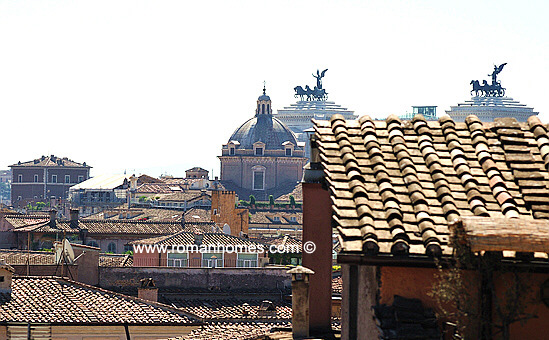 |
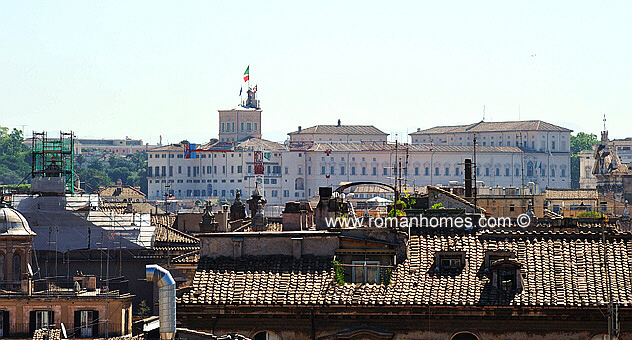
|
The lefto photo shows the Quirinale Palace (Palazzo Quirinale), the current seat of the President of the Italian Republic.
Formerly it was the town palace of the Pope (which was also the monarch of the Kingdom of the Popes). It later became until 1948 the official Rome palace of the Kings of Italy (a dinasty from Northern Italy).
To its left you can see the large gardens of the palace, providing a green area in Rome's congested centre.
|
The domes, the two belfries and the body of the Church of St. Agnes (Chiesa di Sant'Agnese) in Piazza Navona, designed by Francesco Borromini, graciously adorn the silhouette of old Rome's roofs. This church is famous especially for the anedoctical rivalry between Borromini and Bernini, whose famous Fountain of the Four Rivers faces the church in Piazza Navona. You will find more information about the rivalry in this page.
|
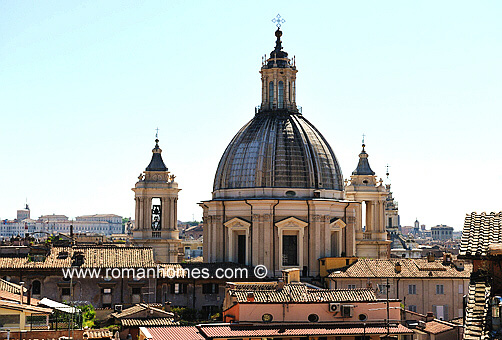 |
Let's take now a closer look of St. Agnes Church, and of many details which at first sight are overlooked.
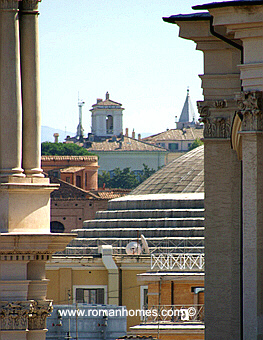 |
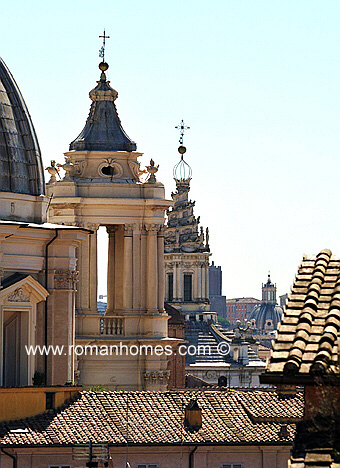 |
Between the dome and the left belfry you can single out the dome of the Pantheon. Built by Marcus Agrippa in the early years of the 2nd century AD, it is the largest dome in Rome to this day (with a diameter of 43.3. meters, larger than St. Peter's!). It was built with concrete (one of the many inventions of ancient Romans), with another peculiar feature, a coffered ceiling to make it lighter.
To the right of St. Agnes Church you see another bright masterpiece of Borromini (left photo): the shell-like dome of St. Ivo alla Sapienza. Immediately to the left, you can see indistinctly the high medieval Torre delle Milizie (also known as Broken Tower or Torre Spaccata, because its top was destroyed by an earthquake), followed by the dome of the Church Santissimo Nome di Maria (Church of the Most Holy Name of Mary), built on the ruins of the ancient library which stood within Trajan's Forum.
In the forest of domes (whose detailed description would make this presentation dispersive), you can single out another noteworthy church: San Luigi dei Francesi (Church of St. Louis of the French).
It is entitled to the Virgin Mary and to Louis IX, king of France. The church was designed by Giacomo della Porta and built by Domenico Fontana between 1518 and 1589. It is the National Church of the French in Rome.
A distinguishing mark is that Giacomo della Porta made the façade as a piece of decorative work entirely independent from the body of the church, a method much copied later. The consequence is that the church is much smaller than the façade would suggest, as it is can be seen looking at the church from its back (which is our case).
The French character is evident in the facade, which has several statues recalling national history, including that of Charlemagne.
In the church you find paintings of many masters, especially of Domenichino and Caravaggio, about the life of St. Matthew. |
|
As you continue rotating to the left (counter clockwise) you can see the top of the Column of Marcus Aurelius, built towards the end of the second century AD to celebrate the victory over three Germanic populations: the Marcomanni, the Quadi, and the Sarmatians. Initially the statue of the emperor Marcus Aurelius stood on top, yet it was replaced in 1589 by the statue of St. Paul.
After the column you see the facade and the roof of Palazzo Montecitorio, seat of the Italian Parliament. |
 |
As you continue rotating counter-clockwise, you see the high quarter near the Spanish Steps, with the park of the Villa Malta, formerly seat of institutions of the Catholic Church.
In the background you can see the silhouette of the Northern Mountains encircling Rome (Monti Sabini, Monti Cimini, Monti Volsini and Monti Sabatini). |
|
If you continue rotating counter-clockwise, there appear a few interesting buildings.
The Collegio Germanico (Germanic Institute) impresses for its awesome size, and it can be singled out also for the large clock of its facade.
Immediately to its left, you can single out the roofs of the Church of St. Apollinare and of San Agostino (St. Augustine). |
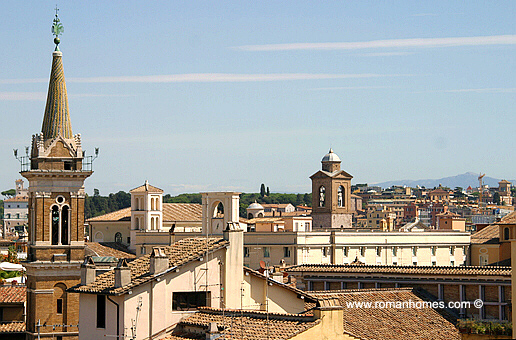 |
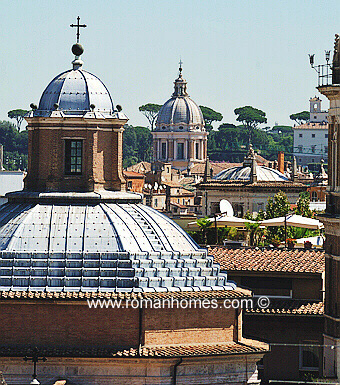
As you keep rotating, a forest of domes and palaces appears: the dome of the Church of Santa Maria della Pace (St. Mary of Peace - left side of these pictures) and the belfry of the Church Santa Maria dell'Anima (right part of the pictures), and between them the dome of the Church San Carlo al Corso, the roof of Palazzo Altemps, and the facade of the Villa Medici in the Borghese Gardens. |
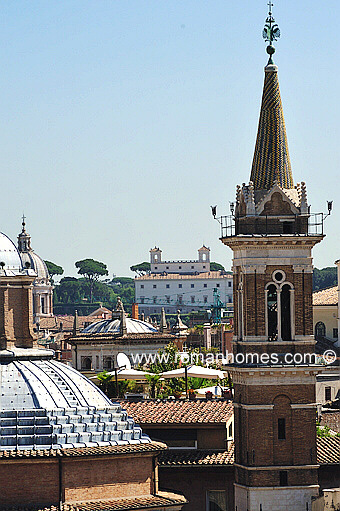 |
The photo to the left is a close-up of the roofs of Palazzo Altemps, whose premises are the seat of many important cultural events and exhibits. |
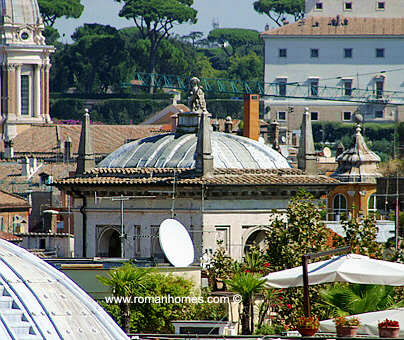 |
| Another view of the dome of the Church Santa Maria della Pace and of the belfry of the Church Santa Maria dell'Anima. This picture is taken from the windows of the apartment. |
 |
The highest part of the Borghese Gardens is called Pincio (pron. Pincho), and it overlooks the centre, with excellent views of Rome, especially at sunset.
The belfry to the left belongs to the Church of St. Patrick, in Via del Babuino. |
|
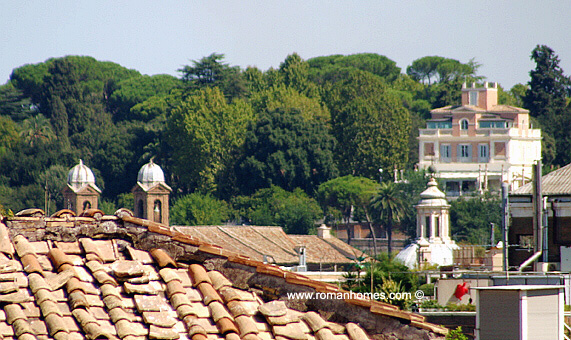
|
A closer look of the Pincio, or highest part of the Borghese Gardens, enables to single out the Casina Valadier, a villa in the park (right part of the left photo) built by the French architect Valadier in the first part of the 19th century.
Since 1920 it is one of Rome's most famous cafes and restaurants, noteworthy for its impressive views of Rome, and also for the extremely refined classical interiors.
You can also single out a few important churches, in particular the Church of San Giacomo degli Incurabili (St. James of the incurable patients) - completed 1600 AD.
The hospital, founded by two cardinals from the Colonna family in the 14th century to aid sick pilgrims, still exists behind the church. The Church is also known as San Giacomo in Augusta, since it is close to the Mausoleum of Augustus.
The two bell-towers flanking the apse are a novelty in Rome, as the normal type of bell-tower is on one side of the façade. |
To the right of the bell-towers of San Giacomo, you can see the dome of the Church of San Rocco, which was completed in the 19th century, and which is also devoted to the cure of patients.
As you keep turning counter-clockwise you can single out other domes and belfries.
The two most prominent domes are those of the "twin" churches in Piazza del Popolo (right photo): Santa Maria in Montesanto (built 1662-75) and Santa Maria dei Miracoli (built 1675-79).
You can also single out the belfry of the Church Santa Maria del Popolo, where you can find beautiful Caravaggio paintings, including the famous Crucifixion of St. Peter. |
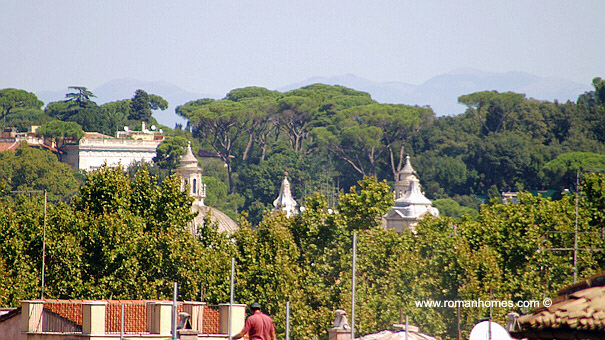 |
| The Court of Justice, dubbed by Romans the "Palazzaccio" (the ugly palace), as it is somewhat pompous and not as charming as the vast majority of Rome's palaces. |
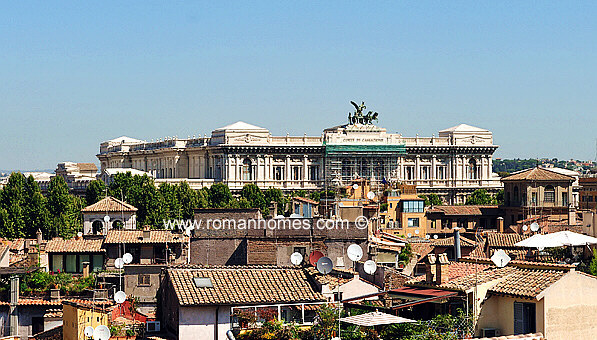 |
The body and the dome of San Salvatore in Lauro.
The little hill behind is called Monte Mario, and it has on its peak an Astronomical Obsertatory (Osservatorio Astronomico), which you can see in the right photo.
From a restaurant - cafe of this hill, called "Zodiaco" (Zodiac) you have another great view of Rome, especially of its Northern areas.
|
 |
Still in the Northern hills of Rome, not distant from Monte Mario, you find the Cavalieri Hilton Hotel, which is renowned to be the most prominent Americanized hotel in Rome.
It is the large palace you can see in the background of the right photo. Needless to say it has a good view of Rome, especially of its Northern areas, and it is also renowned for its panoramic restaurant.
In the right part of the photo you can see instead the highest tower and the statue of the angel of Castel Sant'Angelo.
Formerly the imposing tomb of emperor Hadrian, it became a fort where the Pope found refuge in troubled times. The last time this occurred was in the sack of Rome of the Spanish troops of King Charles V of Spain, in 1527 AD. |
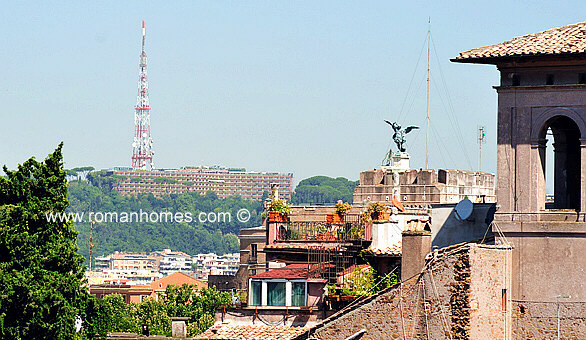 |
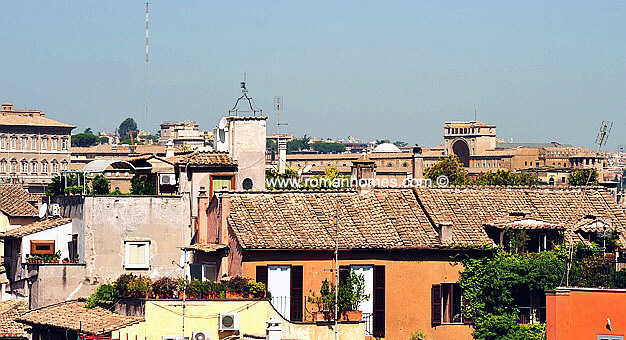 |
The Vatican Museum palace (Musei Vatican) |
|
| The Vatican Palace of the Pope. In the background you can see the huge antenna of the Vatican Radio station. |
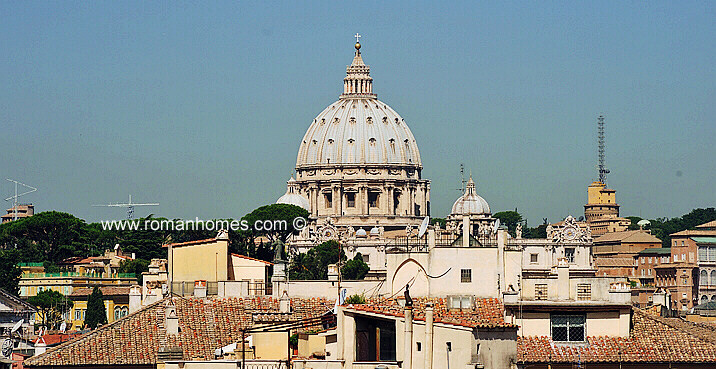 |
St. Peter's Basilica: the imposing dome designed by Micheelangelo (136 Mts. or 446.2 Ft. high). |
You can also see part of the facade, and of its tower clock on the right side. To the left of the basilica you can see the Vatican gardens, while to its right you can see the huge antenna of the Vatican Radio station, broadcasting world-wide.
The photo to the left shows a close-up of Michaelangelo's dome. If you look carefully, you can single out the tourists in the balcony on top of the dome, just under the final columns beneath the cross. |
 |
The Tower Clock (Torre dell'Orologio), by Francesco Borromini. It is the belfry of the Oratorio dei Filippini (the Filippini Friars Oratory), in which Borromini's concept of modelling space following curved lines reaches its apex. You can also single out the roof of the oratory, dotted by chimney caps, whose design and layout is quite imaginative.
To the right of the Tower you see the high, slim dome of the Church of San Giovanni Battista dei Fiorentini, in Via Giulia. For its tapered shape it is dubbed "Il confetto" (the comfit) by Romans.
In the background, behind the dome of the church, you can see the Catholic Pontiff University, near the Vatican. |
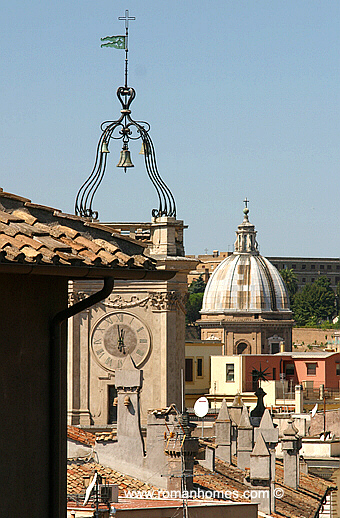
|
The 18th century Church Santa Maria in Vallicella, also named Chiesa Nuova (New Church), having its facade and entry in Corso Vittorio Emanuele.
Behind it, in the background, you can see the Janiculum Hill, which is shown in detail in the photos below. |
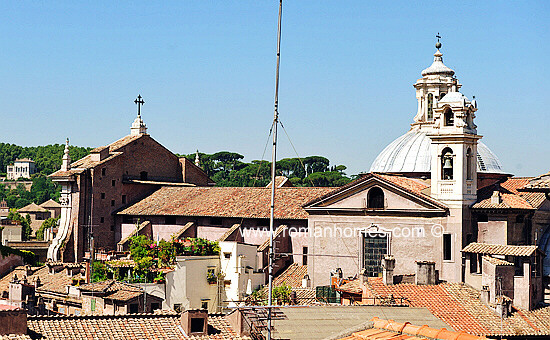 |
| From the terrace you can have a good view of the Janiculum Hill. Although it is the highest of Rome, it was not considered since ancient times one of the 7 hills of Rome. It seems surprising, yet this occurred as it is nearly at the border of the ancient city walls.
In ancient Rome it was a peripheral residential area, with lush villas and gardens. Cleopatra is said to have lodged here during her stay in Rome.
The hill is also famous as it was the site of the battle for the independence of the Roman Republic, occurred in 1848. The Pope (a king, at that time) was dethroned by the patriots seeking independence and a republic (the "second" Rome republic, as the first one was that of ancient times).
The Pope pleaded the help of the French Army (at that time one of the most powerful in the world). The French thought it would have been an easy job to crush the uprising, yet it took many months of bloody fighting in the hill before they could capture Rome.
In the battle Goffredo Mameli, the composer of the Italian national anthem, died as he was only 21 y.o.
In the photo you can see: the high statue of Garibaldy (Italy's national hero) and the square in front of it. On the right side of the photo you see the Villa Lante, endowed with spectacular views of Rome. Today it is the seat of the Embassy of Finland to the Holy See, and also of the Finnish Archeological Institute. |
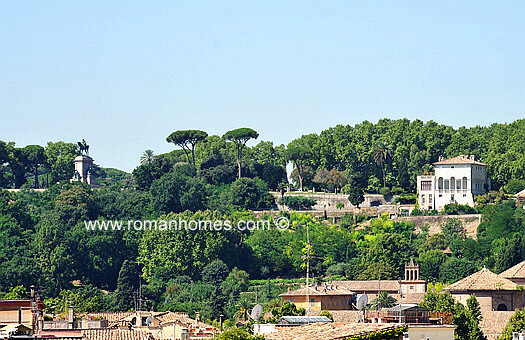 |
Benath the statue of Garibaldi the green, lush areas which you can see are part of the Bothanical Garden (Orto Botanico), while the brownish roofs to the right are part of Regina Cieli (Queen of Heavens), which is Rome's jail.
As you continue rotating anti-clockwise, you see the beautiful white compound with the Paolina Fountain.
It has a square in front, where from you can enjoy a beautiful panoramic view of Rome.
The complex of buildings to its right include the Church of San Pietro in Montorio (where it was thought that St. Peter underwent martyrdom, now we know that it occurred near at the Vatican), and which includes the famous Tempietto del Bramante, a perfect scale model of larger domes. |
 |
A closer view of the background of the Church Chiesa Nuova (Santa Maria in Vallicella) shows as mentioned the Janiculum Hill.
Above the Church ceiling you can see the Manfredi Lighthouse, a gift of the Italians of Argentina (1911) to symbolize the brotherhood of Italians.
From the little terrace in front of the lighthouse you have the widest panoramic view of Rome. |
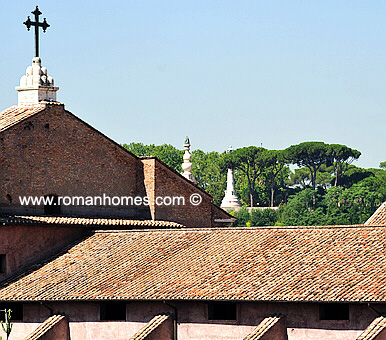 |
Finally in this photo you can see from left to right:
- the higher part of Palazzo Farnese, with contributions also of Michaelangelo, and currently the seat of the French Embassy.
- in front of it you can see the body and the belfy of the church of Santa Brigida.
- in the background you can see the dome of the Church of San Pietro e San Paolo at the EUR, the futuristic peripheral quarter of Rome built by the fascist Regime for the Universal Expo of 1942 (which never occurred because of WW2 occurred, today it is an elitarian residential area, with a few interesting museums). |
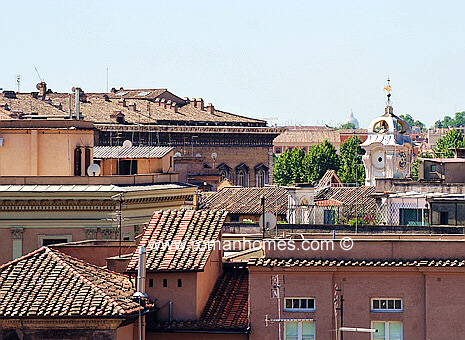 |
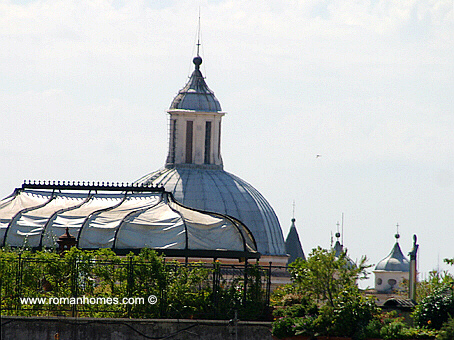 |
In this photo finally you can see the a set of domes, visible after the Palazzo farnese.
Of them, the most prominent is the dome of the Church Santissima Trinita' dei Pellegrini (Church of the Most Holy Trinity of the Pilgrims), which is situated between Campo de' Fiori and the Jewish quarter.
It was dedicated to the Catholic pilgrims visiting Rome. In fact, adjoining there existed a charitable institution hosting pilgrims visiting Rome, as they were held in high regard. |
In the VIEWER below you can see all the sights, monuments, hills and churches that can be seen from the terraces of the attic.
Please be a little patient as the photo is a large file, it takes appr. 10 seconds to download. To see all the sights of the panorama, just put the mouse over the photo, and while pressing it, move it to the left or right (or also up and down!), and the photo will rotate accordingly. PLEASE REMEMBER THAT THIS 360 DEGREE PHOTO WAS TAKEN WITH WIDE ANGLE LENS, SO THE SIGHTS ARE ACTUALLY A LOT CLOSER AND MORE VISIBLE WHEN YOU WILL BE IN THE TERRACES!
Among the countless sights you can see: Piazza Navona St. Agnese church (dome and belfry), the shell-wise dome of St. Ivo alla Sapienza, the Altar of the Fatherland (Victor Emmanuel monument), the Church of Jesus, Palazzo Altieri, the Quirinale Palace (the palace of the Popes, then of the King of Italy, now of the President), the Borghese Gardens, Villa Medici (French Academy), the Pincio Gardens, the Villa Malta, the Palace of Justice, the Monte Mario Hill, Castel St. Angelo, the Farnesina Palace, the Vatican Palaces (including those with the Sixtine Chapel), St. Peter's Basilica, the Tower Clock (Torre dell'Orologio by Francesco Borromini), the Church Chiesa della Pace, the Church of San Salvatore in Lauro, the Janiculum Hill (lighthouse of Mancini, the statue of Garibaldi overlooking Rome, St. Peter in Montorio, the Pauline Fountain), the Church Chiesa Nuova, the Church of St. Paul at the EUR, the Palazzo Farnese - and many others - naturally, also lots of old Rome's roofs!

Visit Rome | Rome panoramic views | Rome apartments and villas | Inquire | Rome travel guide | Rome map | Service | Resources
Roman Homes homepage |

